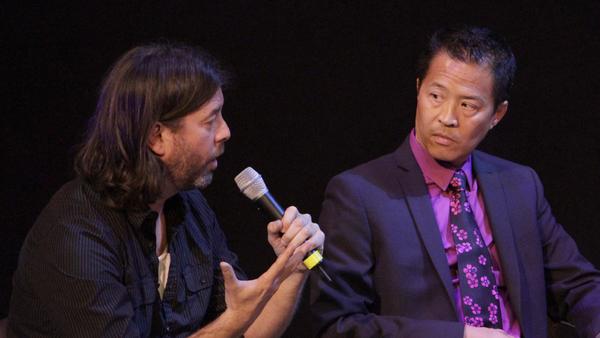available for purchase
at this time.
Link Roundup! – 1/23/15
Link Roundups feature articles and bits of internet goodness that our dramaturgy team digs up. If you find something you want to send our way, drop us a line on Facebook or Twitter!
♦♦♦♦♦

Moderator Michael John Garces, left, of the Cornerstone Theatre Company and Tim Dang of the East West Players, discussed diversity in theater back in 2013. (Lawrence K. Ho / Los Angeles Times)
The LA Times has a story about Tim Dang’s initiative to increase diversity in Southern CA theatres:
California already was declared a predominantly minority population in the 2000 census. Yet 75% of theatergoers in the L.A. region are Caucasian, and 80% are of the baby boomer generation or older, according to a study by the nonprofit L.A. Stage Alliance in 2011, the most recent year for which statistics are available.
Dang and his supporters said that if theater companies were more diverse — by age, sex and skin color — the change would have a ripple effect on what plays or musicals were staged, and what audiences they brought.
♦♦♦♦♦
This post about “trickle down” community engagement over at the Nonprofit With Balls blog is a very important and interesting read for orgs who care about connecting with under-served communities in an authentic way.:
Look, I’m not saying anyone is intentionally trying to discriminate against certain communities. Everyone is well-intentioned. Diversity, equity, inclusion, and cultural competency have risen to the front of people’s minds. Organizations are scrambling to talk about these issues, to diversify their board, to get community input. That is all great and all, but it has only been leading to marginalized communities being irritated and frustrated. Every single week, we leaders of color get asked to provide input, to join an advisory committee, attend a summit, to fill out a survey. Because of this well-intentioned mandate to engage with communities, we get bombarded with requests to do stuff for free.
♦♦♦♦♦
For anyone championing the cause of equal representation in pop culture, this NPR article about the Queens of Africa and Naija Princess doll lines that are outselling Mattel’s Barbie in Nigeria will be a welcome read:
The Queens of Africa dolls are based on Nigeria’s three largest groups — Nneka is Igbo, Wuraola is Yoruba, and Azeezah is Hausa — and each has traits that are meant to empower the girls who play with them. On the company’s website, there’s even a photo of the three dolls holding a #BringBackOurGirls sign. (Okoya has also created books that pair with each of the dolls, so those traits are doubly reinforced.)
♦♦♦♦♦
The Guardian is looking at the new film The Theory of Everything and questioning why actors playing people who are disabled is still an accepted practice.
But is this as harmless as mainstream audiences seem to see it? While “blacking up” is rightly now greeted with outrage, “cripping up” is still greeted with awards. Is there actually much difference between the two? In both cases, actors use prosthetics or props to alter their appearance in order to look like someone from a minority group. In both cases they often manipulate their voice or body to mimic them. They take a job from an actor who genuinely has that characteristic, and, in doing so, perpetuate that group’s under-representation in the industry. They do it for the entertainment of crowds who, by and large, are part of the majority group.
